When travelers think of South Korea, Seoul often takes the spotlight. But nestled along the country’s southeastern coast lies Busan, South Korea’s second largest city, a coastal gem blending modernity, culture, and nature in perfect harmony.
With a population of over 3.4 million, Busan (also spelled Pusan) is more than just a port city—it’s a dynamic hub for tourism, seafood, fashion, and international events. From pristine beaches to mountain temples, and bustling markets to high-rise skylines, Busan offers a unique contrast to Seoul’s fast-paced vibe.
In this article, we explore what makes Busan so special, why it’s worth visiting, and what to see and do when you’re there.
Where is Busan Located?
Busan is located in the southeastern part of South Korea, facing the Korea Strait. It serves as a major gateway for trade and travel, boasting one of the busiest ports in the world—Port of Busan.
Its coastal position gives it a mild climate, beautiful beaches, and a relaxed seaside atmosphere not often found in other Korean metropolises.
Quick Facts About Busan
- Population: ~3.4 million
- Region: Southeastern South Korea
- Main Industries: Shipping, tourism, seafood, fashion, film
- Famous For: Beaches, seafood, temples, international festivals
- Sister City: Los Angeles, California
Top Attractions in Busan
Haeundae Beach
Arguably South Korea’s most famous beach, Haeundae is perfect for sunbathing, swimming, and festivals. Luxury hotels, cafes, and nightlife spots surround this vibrant area.
Gamcheon Culture Village
A colorful hillside neighborhood filled with murals, street art, and charming alleyways. It’s often referred to as the “Santorini of South Korea.”
Jagalchi Fish Market
South Korea’s largest seafood market where you can buy fresh catches and have them cooked on the spot. A must-visit for foodies!
Beomeosa Temple
This 1,300-year-old temple sits at the foot of Geumjeongsan Mountain and offers serene hiking trails and stunning architecture.
Gwangalli Beach & Gwangan Bridge
Known for its views of the massive, illuminated Gwangan Bridge, this beach area is less crowded and perfect for nighttime strolls.
Busan Tower & Yongdusan Park
Climb the Busan Tower for panoramic views of the city and explore nearby cultural exhibitions and parks.
Annual Events in Busan
- Busan International Film Festival (BIFF) – Asia’s most prestigious film festival, held each October.
- Sea Festival – Celebrated on Haeundae and Gwangalli beaches with water sports and performances.
- Jagalchi Festival – Celebrating Busan’s seafood heritage every fall.
- One Asia Festival – K-pop fans flock to this global music celebration each year.
Food Scene in Busan
Busan’s culinary culture is centered around seafood. Must-try dishes include:
- Hoe (raw fish) – Busan’s answer to sushi.
- Ssiat Hotteok – A sweet, nut-filled Korean pancake popular in Nampo-dong.
- Dwaeji Gukbap – Pork and rice soup, a beloved Busan comfort food.
- Mil-myeon – A refreshing cold noodle dish unique to Busan.
Local street food is abundant, especially around BIFF Square and Gukje Market.
Shopping in Busan
Whether you’re into designer brands or quirky souvenirs, Busan has it all:
- Shinsegae Centum City – Recognized as the world’s largest department store.
- Gukje Market – Traditional market for souvenirs, clothes, and food.
- Nampo-dong – A youthful shopping district perfect for K-beauty and fashion finds.
Getting to and Around Busan
- From Seoul: The KTX (Korea Train Express) connects Seoul and Busan in under 3 hours.
- By Plane: Gimhae International Airport serves domestic and international routes.
- Public Transport: A clean and efficient metro system, buses, and taxis make getting around easy.
Where to Stay in Busan
- Luxury: Park Hyatt Busan, Paradise Hotel (Haeundae)
- Mid-Range: Ramada Encore Haeundae, Citadines City Centre
- Budget: Hostels and guesthouses in Seomyeon and Nampo-dong
Busan vs Seoul: What’s the Difference?
| Feature | Seoul | Busan |
| Vibe | Fast-paced, urban | Laid-back, coastal |
| Attractions | Palaces, nightlife, K-pop | Beaches, seafood, temples |
| Population | ~10 million | ~3.4 million |
| Main Draw | Culture, commerce | Nature, relaxation |
While Seoul is Korea’s heartbeat, Busan is its soul—offering a slower, warmer, and more scenic side of Korean life.
Conclusion
If Seoul is the beating heart of South Korea, Busan is the calming breeze by the sea. Its mix of natural beauty, rich culture, and vibrant urban life makes it a must-see destination for any traveler.
Whether you’re a beach lover, a foodie, a festival-goer, or just someone seeking a slower pace, Busan offers the best of both modern and traditional Korea.
Ready to explore South Korea’s second city? Busan is waiting for you.
FAQs
1. What is the second largest city in South Korea?
Busan is South Korea’s second largest city after Seoul, with a population of over 3 million.
2. How do I get from Seoul to Busan?
You can take the KTX high-speed train, which takes under 3 hours, or fly via Gimpo to Gimhae Airport.
3. Is Busan worth visiting?
Absolutely. It offers a mix of beaches, mountains, seafood markets, temples, and vibrant festivals.
4. What is Busan famous for?
Busan is known for Haeundae Beach, Jagalchi Fish Market, Gamcheon Culture Village, and the Busan International Film Festival (BIFF).
5. Is Busan more affordable than Seoul?
Generally, yes. While costs vary, accommodation and local food tend to be more budget-friendly in Busan.




Leave a Comment